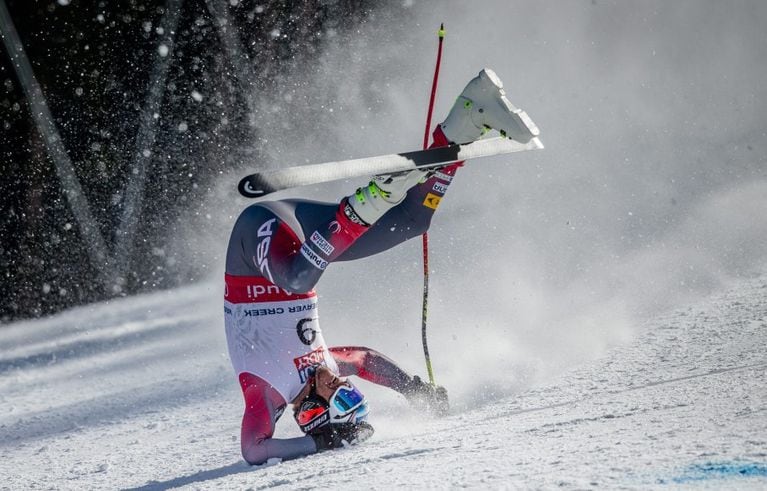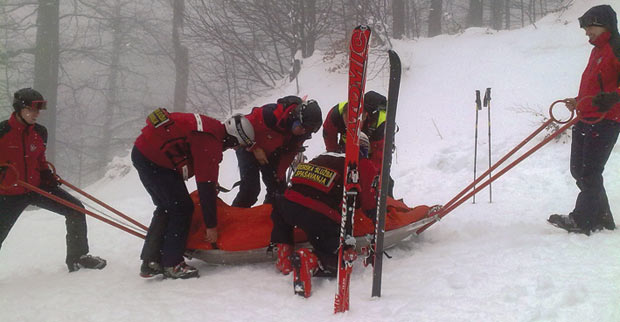
The snow has fallen in northern New England, and skiers and snowboarders are getting ready to hit the slopes or trails. A new study by trauma surgeons at Dartmouth-Hitchcock Medical Center (DHMC) emphasizes that, while wearing a helmet can protect against some injuries, it has limited ability after certain impact forces. Skiing responsibly and within one’s abilities is critical to preventing major head trauma.
Writing in the Journal of Trauma and Acute Care Surgery, the team, led by surgeons Eleah Porter, MD, and Andrew Crockett, MD, reports on a study of ski injuries treated at DHMC from 2010-18. The team investigated the relationship between helmet use, injury types, and injury severity among skiers and snowboarders.
Sixty-five percent of the 721 patients studied—transported to DHMC from 35 ski areas around New Hampshire and Vermont—were wearing helmets. While a variety of injuries to the upper and lower extremities were studied, the most impactful findings were those surrounding helmet use.
One conclusion of the study: despite helmeted skiers and boarders being less likely to suffer skull fractures, lacerations or cervical spine injuries, they were more likely to suffer severe injuries, including intracranial hemorrhage (head bleed). The team also noted that helmeted skiers and boarders were more likely to hit a stationary object, and this mechanism of injury was also associated with having a more severe injury.
“Our bottom line is that it is equally as important to wear a helmet as it is to practice safe skiing,” notes Crockett, the senior author of the study. “A helmet should not dissuade a trauma evaluation and some impact forces go beyond that which a helmet can provide protection.”
Skiing and snowboarding injuries account for more than 50,000 emergency room visits each year. Industry campaigns and the deaths of several high-profile recreational skiers who were not wearing helmets have led to a surge in helmet use, which is at its highest rate in history. Interestingly, however, the Dartmouth team found that while helmet use rates doubled during their study period, the rate of head injuries suffered by skiers and boarders failed to decline.
“One aspect that’s worth considering is the behavioral impact of wearing a helmet,” notes lead author Porter, a native Vermonter and life-long skier. “Previous research has found that wearing a helmet may give skiers or boarders a false sense of security, leading to riskier behavior on the slopes.”

Porter adds that while their data cannot explicitly answer if helmeted skiers and riders engage in riskier behavior, the finding that those helmeted were more likely to hit a stationary object and to have more severe injuries is concerning. “Head bleeds most often occur from deceleration injury,” says Porter, “and a helmet is limited in how much it can dampen these forces.”
Crockett and Porter also note a misperception among some skiers, ski patrol members, and first responders that if an injured skier is helmeted, that he or she may not have suffered a major head injury. “Anyone hitting their head, whether helmeted or not, should be evaluated for, at least, concussion symptoms. Although helmets can protect from lacerations and skull fractures, both minor and major intracranial injuries are still possible,” says Crockett.
“Ski Patrol members and first responders who care for injured skiers and snowboarders should not let the fact that a helmet was used deter referring the injured to a more complete evaluation or to a trauma center,” adds Porter. “We advocate for helmet use, but helmets have limitations and skiing responsibly is a major factor in staying safe and preventing head injuries.”
A New England Journal of Medicine Emergency Medicine review by associate editor Dr. Lauren Westafer supports Porter’s and Crockett’s conclusions. Westafer comments that this is a timely study, reminding both providers and recreational snowsport enthusiasts that “helmets do not protect against all head injuries nor were they intended to do so.” She goes on to write that this DHMC study should “serve as a reminder to clinicians to not be reassured by the presence of a helmet in a patient with concerning clinical features.”
The DHMC research was originally presented in March 2019, at the 49th annual meeting of the Western Trauma Association in Aspen, CO. It appears in the November, 2019, issue of the Journal of Trauma and Acute Care Surgery.